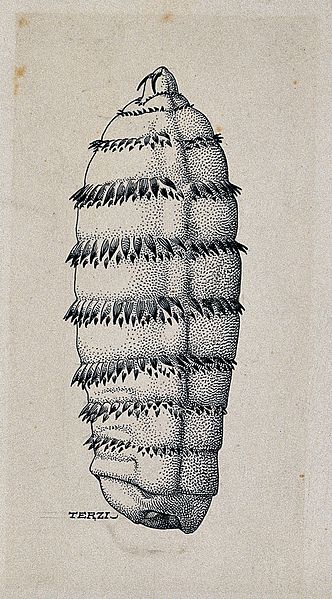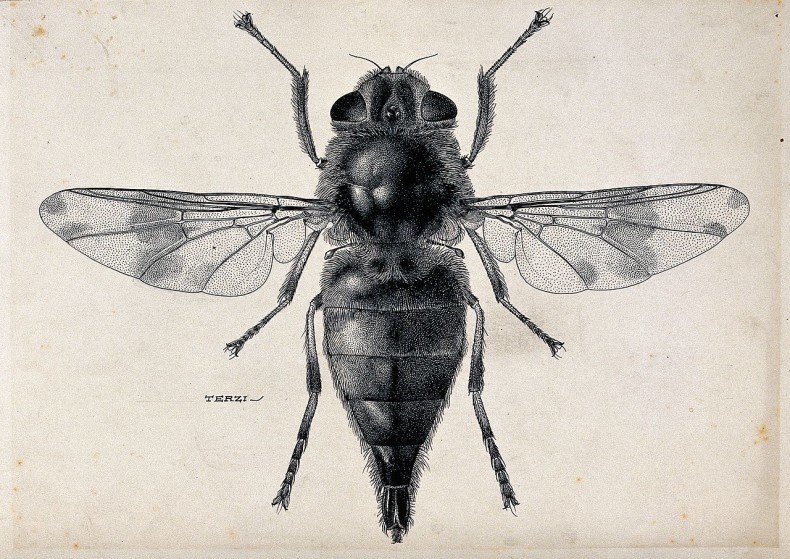I’m not the kind of girl who ordinarily irons her underwear. But two weeks ago I found myself hunched over a flimsy wooden board doing just that. I was visiting friends in Mozambique, and they assured me that everything must be ironed—shirts, pants, sheets, towels, and, yes, even underwear. It’s not about aesthetics. You need the heat to kill the tiny eggs that a female mango fly might have laid on your damp clothes while they dried on the line. If you don’t iron, the eggs will hatch, and the mango fly larvae will burrow into your skin, feast on your flesh, and emerge a week or so later as plump, white maggots.
So this is why I spent a sunny afternoon while on vacation ironing. You can imagine what a nuisance these insects would be if they infiltrated your underwear. Oh wait. You don’t have to imagine. Here’s a case report of an 11-year-old boy who showed up at a British emergency room with “a firm, ovoid, motile mass” on the head of his penis. Motile because the mass contained a wriggling maggot about the size of a pinto bean. The boy had recently visited Somalia.
When you find yourself infested with maggots, you have myiasis. That’s the medical  term. If you’re lucky, the infestation will take the form of a single painful bump on your back or leg or arm. If you’re not so lucky, you might end up with a nostril full of maggots. (NOTE: these links take you to videos that are not meant to viewed at lunch or perhaps at all, depending on your queasiness).
term. If you’re lucky, the infestation will take the form of a single painful bump on your back or leg or arm. If you’re not so lucky, you might end up with a nostril full of maggots. (NOTE: these links take you to videos that are not meant to viewed at lunch or perhaps at all, depending on your queasiness).
The mango fly, native to sub-Saharan Africa, is just one of a handful of species that can provoke myiasis. Africa also has the Congo floor maggot. And Central America has the human botfly. But just to unsettle you, I want to focus on a species that used to live right here in the United States: the New World screwworm.
Rather than laying their eggs on damp clothes, female screwworms tend to lay them near an open wound. That gives their offspring easy access to a fleshy feast. The New World screwworm likely originated in South America, but it eventually migrated north. By the 1930s, the fly had become a real problem in the southern United States, infesting livestock and costing ranchers tens of millions of dollars each year.
Right around that time, an entomologist named Edward Knipling joined the US Department of Agriculture and began studying the screwworm’s biology in Texas. In the lab, he and his colleague Raymond Bushland observed something peculiar: male screwworm flies mate repeatedly but females mate just once. The discovery led Knipling to a bold idea. If he and his USDA colleagues could loose large numbers of sterilized screwworm males into the wild, they might be able to eradicate the pest.
But sterilizing the male screwworm proved challenging. Attempts in the late 1940s and early 1950s to sterilize the flies with chemicals failed. In 1950, however, Knipling read an article that detailed the use of radiation to sterilize fruit flies. Could the same be done for the screwworm? Bushland didn’t have access to an X-ray machine, so he smuggled the flies into an army hospital in San Antonio. He discovered that by subjecting screwworm pupae to a specific dose of radiation, he could produce healthy sterile adults. But Knipling and Bushland still weren’t sure the strategy would work in the wild.
 In 1951, a team of USDA researchers tested the strategy on Sanibel Island in Florida. Although the screwworm population declined, the sterile flies failed to eradicate the insect. But Knipling remained optimistic. In 1954, the USDA launched an even more ambitious experiment on the Dutch island of Curaçao. In August, the researchers began releasing tens of thousands of sterilized male flies imported from a special breeding facility in Florida. Within a couple of months no fertile eggs could be found on the island.
In 1951, a team of USDA researchers tested the strategy on Sanibel Island in Florida. Although the screwworm population declined, the sterile flies failed to eradicate the insect. But Knipling remained optimistic. In 1954, the USDA launched an even more ambitious experiment on the Dutch island of Curaçao. In August, the researchers began releasing tens of thousands of sterilized male flies imported from a special breeding facility in Florida. Within a couple of months no fertile eggs could be found on the island.
The rousing success sparked a full-blown eradication effort. In 1982, the US reported its last case of screwworm infection.
Knipling died in 2000, and his New York Times obituary notes, “For American farmers, what was once a plague is now little more than a memory.” But in an increasingly connected world, can this eradication success story last?
Five years ago, a 70-year-old man showed up at a hospital in Providence, Rhode Island, complaining of shortness of breath and excessive sleepiness. The man was admitted to the hospital and given a breathing tube. According to a 2011 write up of the case, five days later “a nurse observed white thread-like organisms emerging from the patient’s nasal cavity and entering the patient’s mouth.” Those organisms turned out to be screwworm larvae. The man said he hadn’t been out of the country.
The authors speculate that he might have picked up the larvae from friends who were visiting from South America. But it also seems possible he was infected by a screwworm that snuck into the country undetected. Insects don’t respect international borders, and they’re especially hard to apprehend when they’re buried beneath a layer of skin.
***
Images courtesy of Wikimedia Commons.
1. A horse botfly from Wellcome Images
2. A horse botfly larvae from Wellcome Images
3. A researcher irradiating screwworm pupae from the United States Department of Agriculture

2 thoughts on “Unwelcome Worm”
Comments are closed.